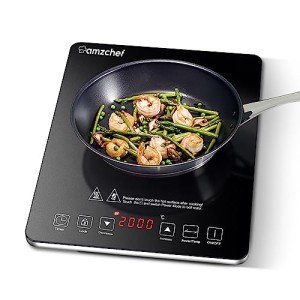Energy-Efficient Induction Hobs: A Comprehensive Guide
Induction hobs have actually become a popular cooking solution amongst modern households, applauded for their speed, performance, and security. As the world becomes more conscious of energy intake and environmental sustainability, energy-efficient induction hobs are paving the way for cleaner and more efficient cooking approaches. Induction Hob Warranty explores the functions, benefits, and considerations of induction hobs, supplying a helpful guide for those seeking to make the switch.
What is an Induction Hob?
Induction hobs work on the concept of electromagnetic induction. Unlike conventional gas or electrical hobs, which warm up the cooktop surface area, induction hobs produce heat straight in the pots and pans. This is accomplished through electromagnetic fields that are produced when an induction coil is stimulated. The benefits of this technique extend beyond effectiveness, as it likewise improves safety and cooking performance.
Secret Features of Induction Hobs
- Fast Cooking: Induction hobs substantially reduce cooking time compared to conventional approaches. They can boil water practically twice as quick as electric hobs.
- Energy Efficiency: Approximately 90% of the heat created is moved directly to the pots and pans, lessening energy waste.
- Exact Temperature Control: Users can control heat levels with remarkable accuracy, which is especially useful for delicate jobs like simmering and melting.
- Cool Cooktop Surface: The cooktop remains reasonably cool, lowering the danger of burns and making cleaning simpler.
- Safety Features: Many induction hobs come geared up with automated shut-off functions, residual heat indicators, and kid lock features.
Benefits of Energy-Efficient Induction Hobs
Energy-efficient induction hobs provide numerous advantages that align with a sustainable way of life. Below are a number of key benefits:
| Benefit | Description |
|---|---|
| Lower Energy Bills | Consuming less energy equates to lower utility expenses. |
| Eco-friendly | Minimized energy intake contributes to lower carbon emissions. |
| Enhanced Cooking Experience | Quick meal preparation and exact control enhances culinary outcomes. |
| More Secure Cooking Environment | Minimized risk of burns and fires due to cool cooktop surface areas. |
| Easy Maintenance | Smooth surfaces are much easier to clean and preserve than conventional options. |
Considerations When Choosing Induction Hobs
While the benefits of induction hobs are compelling, potential buyers should likewise think about numerous aspects before making a purchase.
- Cookware Compatibility: Induction cooking needs magnetic pots and pans. Users need to guarantee their pots and pans are compatible (cast iron and stainless-steel are normally ideal).
- Initial Cost: Induction hobs can be more costly upfront than traditional cooking solutions. However, the long-lasting savings on energy bills may offset this initial financial investment.
- Power Supply Needs: Some induction hobs need higher power supply configurations, which could include extra installation expenses.
- Noise Levels: Some users might find that induction hobs release a humming noise when in usage, especially with certain types of pots and pans.
Choosing the Right Induction Hob
Purchasing an induction hob can be a considerable choice, and comprehending the features and specifications can assist in making an informed option. Here are factors to think about when choosing the ideal induction hob:
Size
- Basic Sizes: Induction hobs come in numerous sizes, normally ranging from 30 cm to 90 cm.
- Burners: Consider the variety of cooking zones you need. Smaller hobs may have 2 or three burners, while bigger models often have four or more.
Features
- Touch Control: Modern induction hobs often feature touch-sensitive controls, using a sleek and modern style.
- Smart Features: Some hobs come with clever technology that integrates with home automation systems for push-button control and monitoring.
- Timer Functionality: This enables users to set cooking times, making sure precision without requiring consistent supervision.
Brand Reputation and Warranty
Choosing a trusted brand name that offers a strong warranty can be vital for long-term complete satisfaction. Research study client reviews and ask about the maker's service policies.
Energy-efficient induction hobs represent a substantial advancement in cooking technology, weding performance with sustainability. Their fast heating abilities, accurate controls, and safety features make them an attractive alternative for any cooking area. While the preliminary costs may be higher, the long-lasting benefits of energy cost savings and boosted cooking experiences present an engaging case for making the switch. As households continue to seek methods to decrease their carbon footprint, induction hobs provide a useful, modern solution.
FAQs
1. What cookware works with induction hobs?Induction hobs deal with magnetic materials. Pots and pans made from cast iron and specific types of stainless-steel are ideal. Non-magnetic materials like aluminum or glass will not work.
2. Are induction hobs safe for kids?Yes, induction hobs are typically thought about safe for kids. The cooktop stays cool to the touch, and lots of models consist of safety locks to avoid unexpected operation.
3. Can I set up an induction hob myself?It is suggested to work with an expert for installation, particularly if your hob requires a higher power supply or complex electrical work.
4. Do induction hobs utilize a great deal of electricity?Induction hobs are understood for their energy efficiency; they generally utilize less electricity compared to standard electric or gas cooktops since they convert nearly 90% of the energy utilized directly into heat for cooking.
5. How do I clean an induction hob?Cleaning an induction hob is straightforward. Use a soft fabric or sponge with warm soapy water. Avoid abrasive cleaners which can scratch the surface area.

